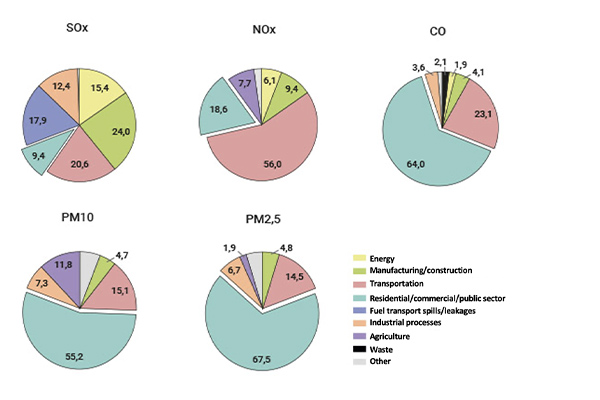Domestic heating: why does it pollute?
In the previous article, we talked about the pollution of cities, and identified 4 primary sources, being traffic, domestic heating, industry, and agriculture. In this post, we would like to focus on heating with some tips for better managing its emissions.
What are the emissions associated with domestic heating?
As we saw in the previous article, from 1990 to today, we have seen a general decline in atmospheric emissions. But how are things in relation to the non-industrial heating sector, which mainly includes domestic heating, as well as commercial and public heating?
Unfortunately not good, since, with the exception of SOx emissions, in contrast with other sectors, this sector has seen significant increases in emissions of almost all the other harmful gases. Let’s see in detail, analysing the cause of these increases.
As we have said, SOx is an exception, with a decrease of 87% compared to 1990, and an amount, in total SOx emissions, of 9%. This reduction came from the replacement of coal, diesel and gas oil with natural gas and liquefied petroleum gas (LPG). It should also be noted that coal has been banned from use in residential and commercial heating, while the percentages of sulfur in diesel and gas oil have been significantly reduced through legislation over the years.
The positive news ends there, as we will now see, NOx, NMVOC, CO, PM10 and PM2.5 emissions have all seen considerable increases in the residential, public and commercial heating sector. Here are the details.
NOx emissions increased by 36%. Non-methane volatile organic compounds (NMVOC) increased by 71%, representing 19% of the total emissions. Carbon monoxide increased by 62% compared to 1990, contributing to 64% of the total emissions.
Regarding PM2.5 and PM10, the sector in question is the main source of emissions, with data that are not comforting at all. In the case of PM10, the contribution is 55% of the total, with an increase of approximately 41% compared to 1990. The same increase was seen in PM2.5, leading the entire sector to account for 67% of total emissions.

Source: Ispra Report - Informative Inventory Report 2020 - Italian Emission Inventory 1990-2018
The cause of these increases lies mainly in the use of biomass (e.g. wood) and solid biofuels (e.g. pellets) as fuel for domestic heating systems. The promotion of renewable energy has also increased the use of biomass as renewable sources, but the strategy has been found to have a negative impact on air quality.
Adding to this is the fact that the adoption of new technologies for residential heating has not seen the same acceleration that has occurred, for example, in the transport sector. This is for two main reasons: the relatively long average life of a boiler, and a lack of adequate incentives for renewal (except for some steps in this direction made over the last few years).
Why does boiler maintenance need to be carried out?
The maintenance of boilers is often seen as a cost gladly avoided if it were not for it being mandatory. However, proper and regular maintenance helps keep emissions to a minimum, and leads to energy savings. How come? To understand this, let’s take a brief aside to talk about how combustion works.
In an ideal combustion scenario, fuel and comburent are present to such an extent that both are used completely, thus drawing the maximum energy out in the form of heat. If we take methane (CH₄) for example, we would have perfect combustion if for each methane atom we used 2 oxygen atoms as comburent, so as to produce heat plus one molecule of CO₂ and two of H₂O.
This type of combustion is of course the ideal, because, in reality, air is used as the comburent, which does not contain oxygen alone, and therefore it is very difficult to achieve a perfect ratio between comburent and fuel, with the consequent production of harmful combustion waste.

Part of the maintenance work on a boiler is precisely to ensure that the combustion process that takes place inside it remains, over the years, as close as possible to the ideal, thus limiting efficiency losses due to normal wear.
Maintenance therefore has two benefits: it preserves the efficiency of the boiler, leading to energy savings; and allows you to control and reduce harmful emissions, to the benefit of the environment.
What is the ideal home temperature?
While good boiler maintenance can undoubtedly play a part in cutting residential sector emissions, another help can come from setting the right temperature for the home.
It goes without saying that the temperature you want to have in your home brings with it a corresponding fuel consumption and related emissions. It has been calculated that from 20°C upwards, costs increase by about 6 to 7% per degrees centigrade. So what is the recommended temperature?
The World Health Organization recommends not exceeding 21°C, which allows you to have an optimal level of comfort and well-being at home. Each of us can therefore check the difference between what is recommended and the temperature we actually keep our homes at. How do you fare? Could you make extra savings, or are you already in line with or doing better than the recommendation?
Finally, there is another thing we can do in terms of domestic heating, namely using a chronothermostat, or “programmable” thermostat.

It should be noted that a boiler, after being off for a while, takes more time and energy to get the home up to a certain temperature than it would have used if it had just been left on.
In this context, using a programmable thermostat can cut energy costs by allowing you to set a comfort temperature and a minimum temperature, and, according to different time bands, only turning the heating on when really needed. In addition, by carefully setting the comfort and minimum time bands, you can optimize the time to reach the desired temperature.